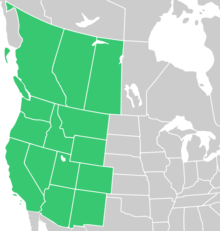| Symphyotrichum eatonii | |
|---|---|

| |
| Conservation status | |
 Secure (NatureServe) | |
| Scientific classification | |
| Kingdom: | Plantae |
| Clade: | Tracheophytes |
| Clade: | Angiosperms |
| Clade: | Eudicots |
| Clade: | Asterids |
| Order: | Asterales |
| Family: | Asteraceae |
| Tribe: | Astereae |
| Subtribe: | Symphyotrichinae |
| Genus: | Symphyotrichum |
| Subgenus: | Symphyotrichum subg. Symphyotrichum |
| Section: | Symphyotrichum sect. Occidentales |
| Species: | S. eatonii |
| Binomial name | |
| Symphyotrichum eatonii (A.Gray) G.L.Nesom | |

| |
| Native distribution | |
| Synonyms | |
Symphyotrichum eatonii (formerly Aster eatonii) is a species of aster known by the common name Eaton's aster. It is native to much of western North America from British Columbia to Saskatchewan, the Sierra Nevada in California, the Rocky Mountains region, to Arizona and New Mexico, where it grows in many habitats, especially wet areas such as meadows and near ditches. It is also known by the scientific name Symphyotrichum bracteolatum.
Description
Symphyotrichum eatonii is a perennial herb growing 40–100 centimeters (1 foot 4 inches – 3 feet 3 inches) from a short rhizome. The thin leaves are up to 20 centimeters (8 inches) long, lance-shaped, and pointed at the tips. Some of the leaves and the upper parts of the stem are hairy.
The inflorescence holds several flower heads containing many white to pink ray florets around a center of yellow disk florets. The fruit is a hairy cypsela that resembles an achene.
Taxonomy
Symphyotrichum eatonii is classified in the subgenus Symphyotrichum, section Occidentales. As of June 2021, Catalogue of Life, Flora of North America, and Jepson eFlora accepted this species as Symphyotrichum bracteolatum, while POWO, NatureServe, and Canadian botanist John C. Semple circumscribed to S. eatonii.
Conservation
Citations
- ^ NatureServe 2021.
- ^ POWO 2021.
- USDA 2015.
- ^ Brouillet et al. 2020.
- Hassler 2021.
- Allen 2012.
- Semple 2021.
References
- Allen, G.A. (2012). "Symphyotrichum bracteolatum". In Jepson Flora Project (ed.). Jepson eFlora. The Jepson Herbarium, University of California, Berkeley. Retrieved 21 June 2021.
- Brouillet, L.; Semple, J.C.; Allen, G.A.; Chambers, K.L.; Sundberg, S.D. (6 November 2020). "Symphyotrichum bracteolatum". Flora of North America (floranorthamerica.org). Point Arena, California: Flora of North America Association. Retrieved 21 June 2021.
- Hassler, M. (17 March 2021). "Symphyotrichum bracteolatum (Nutt.) G. L. Nesom – World Plants: Synonymic Checklists of the Vascular Plants of the World". In Roskov, Y.; Ower, G.; Orrell, T.; Nicolson, D.; Bailly, N.; Kirk, P.M.; Bourgoin, T.; DeWalt, R.E.; Decock, W.; van Nieukerken, E.J.; Penev, L. (eds.). Species 2000 & ITIS Catalogue of Life, 10 June 2021. Leiden, Netherlands: Naturalis Biodiversity Center. ISSN 2405-8858. Retrieved 21 June 2021.
- NatureServe (4 June 2021). "Symphyotrichum eatonii - Eaton's Aster". NatureServe Explorer (explorer.natureserve.org). Arlington, Virginia: NatureServe. Retrieved 21 June 2021.
- POWO (2021). "Symphyotrichum bracteolatum (Nutt.) G.L.Nesom". Plants of the World Online. Royal Botanic Gardens, Kew. Retrieved 12 December 2021.
- Semple, J.C. (17 May 2021). "Symphyotrichum eatonii". Ontario: University of Waterloo. Archived from the original on 21 June 2021. Retrieved 21 June 2021.
- NRCS (2015). "Symphyotrichum eatonii". PLANTS Database. United States Department of Agriculture (USDA). Retrieved 6 December 2015.
External links
- Aster eatonii in the CalPhotos photo database, University of California, Berkeley
| Taxon identifiers | |
|---|---|
| Symphyotrichum eatonii |
|
| Symphyotrichum bracteolatum | |
| Aster foliaceus var. eatonii | |
| Aster bracteolatus | |



